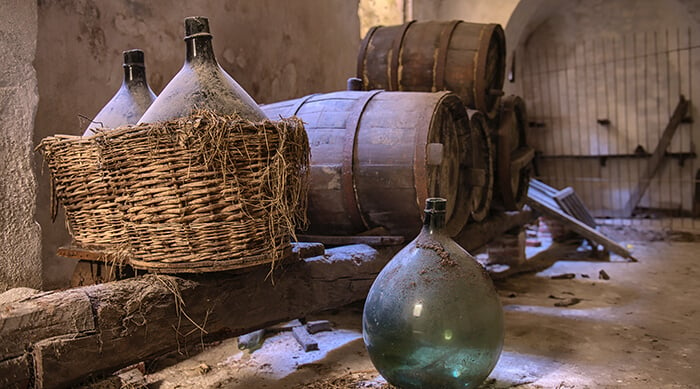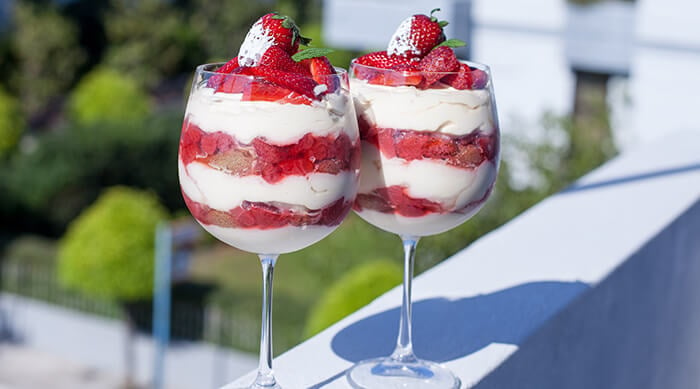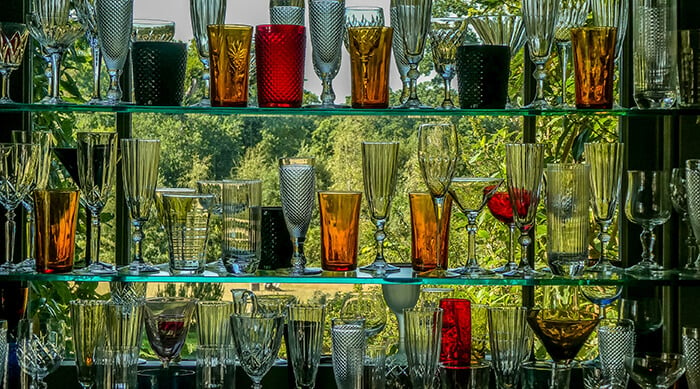Even if you have a good handle on wine basics, some have questions when it comes to fortified wine. Here are a few things to understand right away:
- They’re not the same as dessert wine
- they can be served before or after your meal
- they’re higher in alcohol than your conventional wines
What is fortified wine? Fortified wine is a wine that is made stronger by adding a distilled spirit to its base.
From there, there are varieties and subcategories and regional differences in the world of fortified wine that perplex even the seasoned wine drinker. We’ll try to sort it all out.
A Brief History Lesson
Fortified wine back in the day had little to do with early winemakers seeking a stronger product. They needed a way to preserve wines and prevent oxidation, particularly over long voyages overseas. This was all happening before refrigeration. Base wines stored in casks would sour over time, resulting in wines that tasted more like vinegar.
In the 1600s, winemakers found that by adding spirits, they could extend the shelf life of their product and play with flavors. Over time, these robust wines became after-dinner digestive aids or aperitifs to perk up appetites. Today, you can enjoy fortified wine whenever you like.
How Wines are Fortified
All types of wines start out the same way. The grapes undergo a fermentation process that essentially turns grape juice into alcohol. The fortified winemaking process requires an extra step. A distilled spirit like brandy is added to fortify the base wine.
Is brandy a fortified wine? Brandy is not a fortified wine. It’s a fortifying spirit added to wines to make them stronger. This can happen before or after fermentation.
The timing of distilled spirits can change the flavor profile of a wine. Winemakers who want a sweeter fortified wine add the spirits before fermentation. If you’re watching your sugar content, choose a dry style. Dry fortified wines are fortified after fermentation.
Does fortified wine have more alcohol than unfortified wine? Fortified wine typically has more alcohol than unfortified wine.
The average alcohol content of most fortified wines is an ABV of 17-20%. Some fortified wines are even higher in alcohol, and go well above 20% ABV. Fortified wines are also higher in calories than conventional wines, so if you’re seeking a healthier wine, sip carefully.
Port, for example, has about 50 calories per ounce. Red wine has about 25 calories per ounce. That means moderation is key when you’re enjoying fortified wines. They’re not considered the healthiest wine choice when it comes to either alcohol content or your diet.
Types of Fortified Wines
While the basic process for fortified wines is similar across the board, winemakers tweak that process depending on the type of fortified wine they’re bottling.
What are the two most popular fortified wines? The two most popular fortified wines are port and sherry. Add madeira and marsala to the list and you’ve covered the 4 main types of fortified wine.
Outside of the 4 main types, there are more regional fortified wines, organic and functional wines, and subcategories.
Vermouth, a popular mixer for vodka cocktails, is an aromatized fortified wine. We’ll get into that after we dive into 6 different types of fortified wines, starting with the 4 most popular.
Port
Port wine is by far the most popular fortified wine, often appearing at the end of wine tastings. The original is from northern Portugal’s Douro Valley, and traditional preparations start with a sweet red wine as its base.
There are several different styles of port ranging in color from purple to white:
- Ruby Port: This deep red port is sweet and fruity and made from a blend of red wines.
- Tawny Port: This brown to orange port is known for its nutty, caramelized aftertaste.
- White Port: A blend of white wine grapes, this golden port ranges from off-dry to sweet.
- Rosé Port: This port is made with rosé wine with more notes of citrus than other ports.
If you’re lucky enough to get your hands on a vintage port, that refers to a port made of grapes from a single harvest. These ports are the best of the best, bottled young and then set aside to age in the bottle. Some vintage ports age for decades before they’re sold to consumers.
Madeira
This Portuguese fortified wine from the Madeira islands can come both sweet or dry. It’s well-known for the unique aging process called estufagem that gives the wine its character.
Back in the 15th century when Madeira came onto the scene, this aging process occurred naturally. Long voyages through hot climates heated up the wine barrels to the point of oxidation.
Today, that process is replicated using steam or hot water tanks, although some winemakers in warmer climates let nature take its course for aging over several years.
Marsala
Marsala wine comes from Sicily, just off Italy’s southern coast. Lower-quality versions are common in grocery stores, as this one has become a popular cooking wine. If you want a sipping marsala, pay close attention to the label. A good Marsala should always come from Sicily.
Marsala styles come in both sweet and dry. High-quality Marsala should have tasting notes of dried fruits like apricot and cherry, honey, and walnut.
Sherry
In the United States, sherry has a reputation as a sticky sweet addition to your cooking. That accessibility means many are missing out on real sherry.
Traditional sherry is made of Palomino grapes grown in Andalusia, Spain. The heart of Spanish sherry production is in the town of Jerez de la Frontera.
Some sherry winemakers use a special kind of yeast called flor to adjust the wine’s total alcohol content. The end product is drier, pairs well with food, and is big on aromatic flavor. This isn’t your mother’s cream sherry. Here are a few popular styles of sherry:
- Amontillado: This sherry has a deep amber color with flavors of nut and dried fruit.
- Fino: This dry sherry is best served chilled. It’s light with an aftertaste of almond.
- Manzanilla: This light and dry sherry is more like a crisp white wine than a fortified wine.
- Oloroso: Intensely-flavored with a good amount of nuttiness, this sherry is on the dry side.
- Pedro Ximénez: Syrupy and sweet, this unique sherry is made from white grapes.
Moscatel de Setúbal
If you want to show off your knowledge of fortified wines, pick up a bottle of this niche Portuguese option. Moscatel de Setúbal is similar to port but made primarily from fortified Muscat grapes.
José Maria da Fonseca, Portugal’s oldest table wine company, is credited with inventing this fortified wine style. This one falls in the very-sweet category, with flavor notes of honey, caramel, and dried apricot.
Rutherglen Muscat
This fortified wine is unique for where it’s produced. Rutherglen Muscat comes from Australia. Not surprisingly, it’s made from a variety of Muscat grapes, so the flavor is quite sweet. Rare styles of this wine are aged for decades to enhance notes of caramel, dried fruit, and toffee.
Aromatized Wine
Fortified wine is even more diverse when you throw its subcategories into the mix. The most popular is aromatized wine. These wines blend fortified wines with herbs, spices, or other flavors for a completely unique tasting profile and distinct aromas.
Let’s take a look at a few of the most popular.
Americano
This Italian wine has nothing to do with Americans. The “amer” in the name refers to the French word for “bitter.” This aromatized wine comes in bright red or yellow, but the flavor always leans bitter. That’s thanks to the gentian root used for the flavor profile.
Quinquina
Quinquina is spiced with cinchona bark, a citrusy, bitter plant. If you’ve ever had French Lillet, a blend of Bordeaux wine from France and different citrus liqueurs, you’ve had this aromatised wine style. It’s popular in spritz-style cocktails or paired with seltzer.
Vermouth
Vermouth is the most popular aromatized wine and a key component of martinis. It comes in 2 styles, dry and sweet. Dry vermouth, or French vermouth, is a blend of white wine, herbs and spices, and brandy for fortification.
Sweet vermouth, or Italian vermouth, is made from white or red wine, herbs and spices, and a fortifying spirit. It’s much fruitier and often sweetened with caramelized sugar. Manhattan recipes typically call for sweet vermouth.
If you love the taste of vermouth but want to cut back on the alcohol, non-alcoholic spirit brands have come up with high-quality, alcohol-free vermouth to mix or drink straight up.
Fortified Wine Aging
Many fortified wines won’t hit store shelves until they’ve aged to a winemaker’s preferences.
You’ve already heard about Madeira and estufagem. Fortified wines like sherry are also aged using a specific kind of called solera. This system of aging wine was popularized by Spanish and Portuguese winemakers to bring more consistency to vintage wines.
After sherry is fortified with grape spirits, it’s poured into barrels that are stacked on top of one another in rows. This is the solera. The top row gets the newest sherry, the second row gets the previous year’s sherry, and so on down to the last row.
The last row in the solera is the oldest sherry, and what eventually gets bottled for sale and sipping. This is why you won’t find a “vintage” sherry. When it’s prepared in this way, it’s always a blend of all different kinds of sherry.
Storage Recommendations
Optimal storage varies based on wine style. Generally, store unopened bottles in cool, dark places without temperature swings. They should be fine for several months thanks to the fortifying spirits added to the wine. Vintage ports can sit for much longer.
Most opened bottles of fortified wine should be finished within a few days. Store opened bottles in the fridge in between pours.
How to Serve Fortified Wine
What’s the best way to drink fortified wine? The best way to drink fortified wine is the same way you’d drink traditional wine, just in a smaller serving size. A serving size of most fortified wines is about 3 oz.
Whether you chill or serve at room temperature depends on the type of fortified wine. Most ports are best just under room temperature. Warm-weather ports can be served on the rocks. Some fortified wines work well in mixed drinks and cocktails. Others are delicious as cooking wines.
Pairing Dessert Wines
You can treat many sweet fortified wines like dessert wines. Consider the tasting notes you get from those wines when plotting out your sweets. Here are a few examples:
- Ruby Port is bright and fruity. Chocolate and berry pies are a natural combination for the wine’s rich texture.
- Marsala wines work well with decadent chocolate desserts like truffles or tiramisu. Try a semi-dry variety if your dessert is more savory.
- Play off the caramel notes in a Tawny Port with a crème brûlée or dried fruits. If you want to serve this one ahead of a meal, it’s great with nuts, too.
A dry fortified wine can be used like an aperitif. Serve your cheese and crackers with a dry sherry.
If you want to serve non-alcoholic drinks along with your sweets or hors d'oeuvres, you have options outside of fortified wines. Surely’s non-alcoholic wines pair well with whatever is on the menu, and you don’t need to watch your serving sizes.
Try our non-alcoholic sparkling white with your cheese board or the non-alcoholic pinot noir with your chocolate tart. Surely wine is versatile and delicious.






![Sugar in Wine by Type [Plus, Sugar in Winemaking]](https://dropinblog.net/34240221/files/featured/sugar-in-wine.jpg)